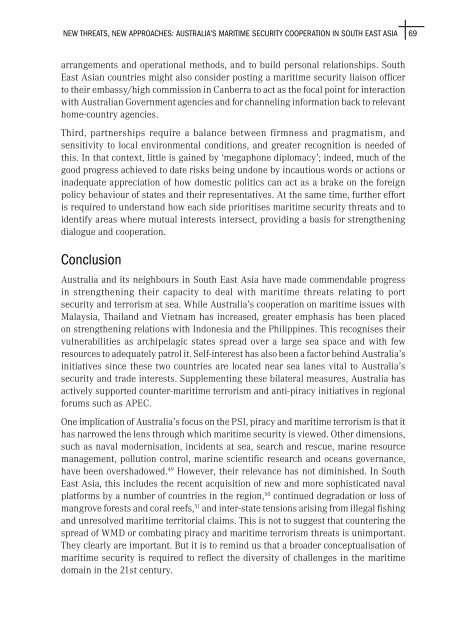Australian Maritime Issues 2007 - Royal Australian Navy
Australian Maritime Issues 2007 - Royal Australian Navy
Australian Maritime Issues 2007 - Royal Australian Navy
You also want an ePaper? Increase the reach of your titles
YUMPU automatically turns print PDFs into web optimized ePapers that Google loves.
New Threats, New Approaches: Australia’s <strong>Maritime</strong> Security Cooperation in South East Asia<br />
69<br />
arrangements and operational methods, and to build personal relationships. South<br />
East Asian countries might also consider posting a maritime security liaison officer<br />
to their embassy/high commission in Canberra to act as the focal point for interaction<br />
with <strong>Australian</strong> Government agencies and for channeling information back to relevant<br />
home-country agencies.<br />
Third, partnerships require a balance between firmness and pragmatism, and<br />
sensitivity to local environmental conditions, and greater recognition is needed of<br />
this. In that context, little is gained by ‘megaphone diplomacy’; indeed, much of the<br />
good progress achieved to date risks being undone by incautious words or actions or<br />
inadequate appreciation of how domestic politics can act as a brake on the foreign<br />
policy behaviour of states and their representatives. At the same time, further effort<br />
is required to understand how each side prioritises maritime security threats and to<br />
identify areas where mutual interests intersect, providing a basis for strengthening<br />
dialogue and cooperation.<br />
Conclusion<br />
Australia and its neighbours in South East Asia have made commendable progress<br />
in strengthening their capacity to deal with maritime threats relating to port<br />
security and terrorism at sea. While Australia’s cooperation on maritime issues with<br />
Malaysia, Thailand and Vietnam has increased, greater emphasis has been placed<br />
on strengthening relations with Indonesia and the Philippines. This recognises their<br />
vulnerabilities as archipelagic states spread over a large sea space and with few<br />
resources to adequately patrol it. Self-interest has also been a factor behind Australia’s<br />
initiatives since these two countries are located near sea lanes vital to Australia’s<br />
security and trade interests. Supplementing these bilateral measures, Australia has<br />
actively supported counter-maritime terrorism and anti-piracy initiatives in regional<br />
forums such as APEC.<br />
One implication of Australia’s focus on the PSI, piracy and maritime terrorism is that it<br />
has narrowed the lens through which maritime security is viewed. Other dimensions,<br />
such as naval modernisation, incidents at sea, search and rescue, marine resource<br />
management, pollution control, marine scientific research and oceans governance,<br />
have been overshadowed. 49 However, their relevance has not diminished. In South<br />
East Asia, this includes the recent acquisition of new and more sophisticated naval<br />
platforms by a number of countries in the region, 50 continued degradation or loss of<br />
mangrove forests and coral reefs, 51 and inter-state tensions arising from illegal fishing<br />
and unresolved maritime territorial claims. This is not to suggest that countering the<br />
spread of WMD or combating piracy and maritime terrorism threats is unimportant.<br />
They clearly are important. But it is to remind us that a broader conceptualisation of<br />
maritime security is required to reflect the diversity of challenges in the maritime<br />
domain in the 21st century.
















